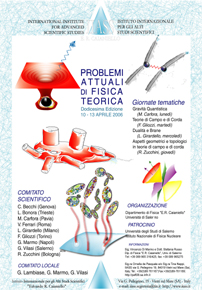Problemi Attuali di Fisica Teorica 06
Posted by Urs Schreiber
This year’s conference in the annual series Problemi Attuali di Fisica Teorica will be held April 7 - April 13 in Vietri, Italy (like last year).

The HEP program is
Monday 10 - Quantum Gravity
Tuesday 11 - Strings and Fields
Wednesday 12 - Duality and Branes
Thursday 13 - Geometric and topological aspects of strings and branes
1) Non Abelian gerbes and brane theory.
2) Manifolds, supermanifolds, special holonomy and superstring compactifications.
3) Generalized complex geometry and supersymmetric sigma models.
4) Poisson geometry and non commutative geometry.
Francesco Bonechi
(I.N.F.N., Firenze)
The Poisson sigma model and the quantization of Poisson manifolds
Abstract: The Poisson sigma model is a bidimensional field theory having as target manifold a Poisson manifold. Kontsevich formula for the deformation quantization of the target manifold is interpretable as the perturbative expansion of a particular correlator of the model. The non perturbative dynamics of the model is instead still largely unexplored. In this seminar, we clarify the meaning of the inegrality condition of the Poisson tensor which appears both in the integration of the gauge transformations of the model and in the geometric quantization of the target manifold.
Francesco D’Andrea (S.I.S.S.A., Trieste)
Local index formulas on quantum spheres
Abstract: A general introduction to the basic ideas of index theory in noncommutative geometry is presented, clarified through the q-sphere example. One of the main motivation of this work is the classification of deformations of instantons, whose charge can be computed using the local formulae of Connes-Moscovici. After a brief introduction of the main notions, some results concerning the geometrical properties of the quantum SU(2) group and of Podles spheres, which are deformation of the Lie group SU(2) and of Riemann sphere, respectively, will be discussed. Finally, the outlook of the subject and in particular the connection with the theory of modular forms will be illustrated.
Jarah Evslin (Free University, Bruxelles)
Twisted K-Theory as a BRST Cohomology
Abstract: We argue that twisted K-theory is a BRST cohomology. The original Hilbert space is the integral cohomology of a spatial slice, corresponding to the lattice of quantized Ramond-Ramond field strengths. The gauge symmetry consists of large gauge transformations that correspond geometrically to choices of trivializations of gerbes. The BRST operator is identified with the differential of the Atiyah-Hirzebruch spectral sequence.
Branislav Jurco (Munich University, Munich)
Nonabelian gerbes, differential geometry and stringy applications
Abstract: We will discuss nonabelian gerbes and their twistings as well as the corresponding differential geometry. We describe the classifying space, the corresponding universal gerbe and their relation to string group and string bundles. Finally we show the relevance of twisted nonabelian gebres in the study and resolution of global anomalies of multiple coinciding M5-branes.
Urs Schreiber (Hamburg University, Hamburg)
Surface transport, gerbes, TFT and CFT
Abstract: Segal’s conception of a 2D QFT as a functor on cobordisms may be refined to that of a 2-functor on surface elements. Surface transport in gerbes, as well as 2D TFTs and CFTs provide examples.
Alessandro Tanzini (SISSA Trieste)
Recent developments in topological brane theories
Abstract: We will discuss the formulation of topological theories for branes and its relevance for the recent conjectures about S-duality in topological string and topological M theory.
Alessandro Torrielli (Humboldt University, Berlin)
D-brane decay in electric fields and noncommutative geometry
Abstract: We study tachyon condensation in the presence of overcritical electric fluxes, by means of a toy model based on the noncommutative deformation of the one proposed by Minahan and Zwiebach. We discuss the relation with Sen’s standard picture of D-brane decay, and the connection with the S-brane paradigma.
Maxim Zabzine (Upsala University, Upsala, and University of California, Santa Barbara)
New results in generalized Kahler geometry
Abstract: I will review the different decsriptions of generalized Kahler geometry and its relation with supersymmetric sigma model. I will sketch the proof of the existence of generalized Kahler potential and will explain the relation to off-shell supersymmetry.
